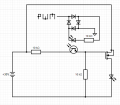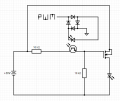Trying to design a photo-enlarger, and as part of it, I need to be able to control the relative brightness of a 20w cobb led thats powered off of 30v. I'm trying to use an off the shelf mosfet board (HW-700) that I had around that I can use alongside an arduino to control the led using pwm. However, no matter what I do, it doesnt seem to be working. Based on my (granted, rudimentary probing), the board config roughly looks like this:

I've added the 30v connection and the led coming off the mosfet shown above.
It's relatively basic, full-bridge rectifier sending the pwm signal to the octocoupler input, supposedly switching the phototransistor on and off, turning on and off the mosfet that controls the LED. I've verified that the PWM signal looks good from the arduino on the oscilloscope, but for some reason the voltage coming from the emitter of the octocoupler is only around .5v instead of the expected 15v. I've swapped out optocouplers, but there seems to be no difference. I'm using a V0615a optocoupler, HA210N06 mosfet btw.
Any advice would be appreciated.

I've added the 30v connection and the led coming off the mosfet shown above.
It's relatively basic, full-bridge rectifier sending the pwm signal to the octocoupler input, supposedly switching the phototransistor on and off, turning on and off the mosfet that controls the LED. I've verified that the PWM signal looks good from the arduino on the oscilloscope, but for some reason the voltage coming from the emitter of the octocoupler is only around .5v instead of the expected 15v. I've swapped out optocouplers, but there seems to be no difference. I'm using a V0615a optocoupler, HA210N06 mosfet btw.
Any advice would be appreciated.
Attachments
-
19.7 KB Views: 3










